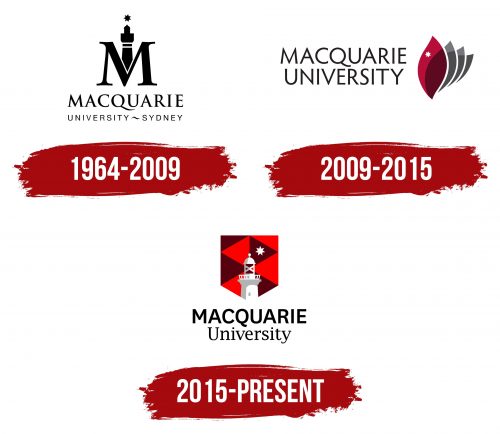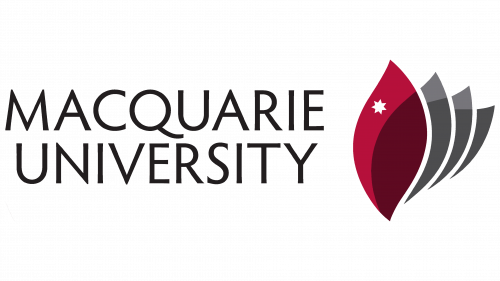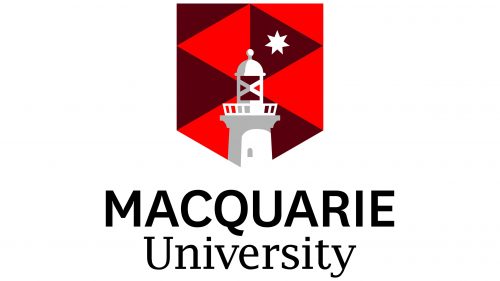The Macquarie University logo combines current trends from different eras, symbolizing strength, faith, and reliability in a unified configuration. The color scheme and the introduced graphic elements create a harmonious and memorable image, distinguished by mathematical precision in proportions and balanced height. The three background colors, used on different planes, blend perfectly, emphasizing the unity and thoughtfulness of the design.
Special attention is drawn to the font used for the university’s name. It is presented on two levels, with the words scaled differently and the second word carefully centered relative to the first. The font skillfully combines boldness and elegance, giving the text expressiveness and significance.
The depiction of the lighthouse, placed on a two-dimensional background, enhances the overall meaning of the logo, adding informational depth. This element, previously used in earlier university logos, continues the tradition, but in the new design, it plays an even more important role, strengthening Macquarie University’s identity and visual integrity.
Macquarie University: Brand overview
The Australian government of New South Wales opened a third university in Sydney in 1964, marking the beginning of Macquarie University’s history. This decision was made in reaction to Sydney’s explosive population growth and the post-war increase in demand for higher education.
The university’s name is Lachlan Macquarie, the fifth governor of New South Wales, who was instrumental in the colony’s growth in the early 1800s.
Work began in 1964 on the 126-hectare campus in the northern suburb of North Ryde. The site was chosen because it was accessible to growing industrial districts and had room for future growth.
The university was officially inaugurated on August 6, 1964, and the first students enrolled in classes in 1967. It was founded with the Arts, Science, and Economics faculties.
Professor Alexander George Mitchell was the university’s first vice-chancellor and held the position until 1975. Under his direction, the institution’s distinctive culture and pedagogical tenets were established.
The educational institution set out to set itself apart from other conventional Australian universities right from the start. It used an interdisciplinary approach to teaching, enabling students to take courses from several academic disciplines. At the time, this was a novel for Australian higher education.
The university established Australia’s first earth sciences faculty in 1969 in response to the expanding significance of geology and related fields to the national economy.
The institution experienced tremendous expansion during the 1970s. In 1972 and 1974, the Australian Graduate School of Management and the School of Law were founded as new faculties and schools.
In 1978, the institution established the first private non-profit teaching hospital connected to an Australian university, the university hospital. This greatly increased the organization’s capacity for medical and research.
Expansion and development continued into the 1980s and 1990s. In 1981 and 1989, the Centre for Cognitive Science and Ecosystem Function were established as new research centers.
The first Australian university to provide actuarial study was this institution in 1990, in response to the growing need for financial risk management experts.
Campus infrastructure experienced large upgrades in the 2000s. In addition to opening new academic buildings and research institutes, a new library complex was constructed.
2010, a new $250 million hospital complex opened, greatly enhancing the school’s medical and research studies capacity.
With the opening of the university’s new Earth Sciences Center in 2011, researchers and students now have access to cutting-edge geology and earth sciences technologies.
The Global Leadership Program, an ambitious initiative, was introduced in 2012. This program aimed to help students become more capable leaders and prepare them for the workforce in a global setting.
In 2014, several events marked the university’s 50th anniversary and showcased its accomplishments over the previous 50 years.
2015 was a landmark year for the educational institution’s medical education program. With the opening of the Dr. Chau Chak Wing School of Medicine, the organization greatly improved medical education.
The university Incubator was established in 2016 as a place where faculty and staff may work on creative initiatives and startups.
A new 120-million-dollar Arts Faculty building opened in 2018, demonstrating the institution’s dedication to the humanities.
A new degree structure was implemented in 2019, giving students more options regarding courses and specializations.
In 2020, the institution introduced a new plan called “Accelerated Excellence,” which aims to improve the caliber of education and increase research potential. This plan included investments in important fields of innovation and research.
The brand-new Applied Finance Center opened its doors in 2021. Its purpose is to improve the relationship between financial practice and scholarly research.
In the same year, the organization unveiled a redesigned MBA curriculum emphasizing technology and innovation, created to satisfy contemporary corporate requirements.
In 2022, the institution made robotics and artificial intelligence advancements and established a brand-new, cutting-edge robotics and AI lab.
The university prioritized social justice and equality. An Indigenous Strategy initiative was introduced to assist and broaden the chances of Indigenous Australian students.
The organization celebrated a noteworthy development in quantum science in 2023. Advancements in quantum computing were made by university researchers, solidifying the institution’s standing as a pioneer in this area.
The educational institution has continued to deepen its global ties throughout this time. Thanks to new collaboration agreements with top universities in Europe and Asia, there are now more options for collaborative research projects and student exchanges.
Additionally, the organization actively promoted online learning, increasing the variety of distance learning courses offered. This enabled the educational institution to interact with students from around the world.
The university emphasized an interdisciplinary research approach, promoting cooperation across various colleges and research units.
The institution has strived to balance the basic and applied sciences, the humanities, and the natural sciences. It is now known for its dedication to innovation and interdisciplinarity.
Meaning and History
What is Macquarie University?
This university is a public research institution in the Macquarie Park area of Sydney, Australia. It offers a wide range of undergraduate and postgraduate courses in arts, business, science, engineering, and health sciences, among other areas. The university is renowned for its cutting-edge approach to teaching, with a strong focus on interdisciplinary courses and practical placements and more on a modern, park-like university campus, including Australia’s first and only private hospital on a university campus, Macquarie University Hospital. The university is well known for its research output and has a strong reputation in commerce, linguistics, and environmental sciences.
1964 – 2009
The university’s first logo was introduced in 1964 when Macquarie University debuted. This emblem attracted attention with its unique aesthetics and deep symbolism. The logo was conventionally divided into three levels, which gave it a special mystical appeal. It could be perceived from top to bottom or in reverse, giving it a layered and meaningful appearance.
At the top of the logo, a rising star was depicted on a white background that united all the levels. The star’s black color contrasted with the white background, creating the illusion of light breaking through darkness, symbolizing the path to knowledge. This graphic element played with the imagination, evoking associations with light in the night, illuminating the way forward.
Below the star was the letter “M,” behind which a lighthouse seemed to be hidden — the central element of the logo. The lighthouse shared its significance with the letter “M,” emphasizing their equal importance. This combination of symbols made the university’s logo visually appealing and rich in meaning.
Space was reserved at the bottom of the logo for the university’s name. At that time, including an institution’s full or abbreviated name in logos was mandatory, and Macquarie University was no exception. The words “University” and “Sydney” were placed on the same line, connected by a graphic sign “~,” which gave the logo a particular elegance and completeness.
2009 – 2015
2009, the original Macquarie University logo underwent significant changes, resulting in a new look. Many previous elements were replaced with new images filled with symbolism and sacred meaning. This redesign allowed the university to present itself in a new light while maintaining its core identity.
The name “Macquarie University” remained on the logo, but its visual execution was updated. It is now written in two lines, using a new font emphasizing the institution’s prestige and reliability. The graphic separations from previous logo versions disappeared, and now both words appear uniform and harmonious. The only change is a slight offset of the second word relative to the first. The black color of the letters emphasizes the strictness and elegance of the logo.
To the right of the university’s name is a graphic element—a petal, done in maroon with three gray shadows that add depth and volume. This element became the symbol of the new logo. On the maroon petal is a barely noticeable white star, which seems to have transitioned from the previous logo, preserving continuity and a connection with history.
2015 – today
The star has always remained a constant element of Macquarie University’s identity, appearing on the logo throughout its existence. The latest logo transformation combines familiar and new elements, creating a harmonious and recognizable visual design. The logo once again includes the key symbols—the lighthouse, the star, and the elegant university name, written in two lines.
In the new version of the logo, more colors are used, and a shield has been introduced, with its inner space divided into equal triangles. These triangles alternate between red and maroon shades, giving the logo dynamism and depth. The overall background of the logo remains solid white, creating a sharp contrast with the rich colors of the shield, highlighting the uniqueness and significance of each element.
The Seal
The university seal plays a significant role. Macquarie University paid special attention to its creation to ensure it is presentable and accurately reflects its key activities. The seal is highly informative and easily memorable, thanks to its carefully thought-out elements.
The main background of the seal is green, creating a sense of freshness and stability. Against this background, a white lighthouse stands on a pedestal, symbolizing the light of knowledge and guidance. The star, which consistently appears on logos from different periods, is presented in a gold shade with a shimmer, adding elegance and emphasizing the university’s status. This element, positioned at the top of the seal, gives it a sense of completeness and importance, making it a symbol that reflects tradition and the pursuit of high standards.








